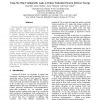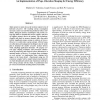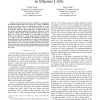IEEEPACT
2002
IEEE
14 years 4 months ago
2002
IEEE
Energy efficiency in microarchitectures has become a necessity. Significant dynamic energy savings can be realized for adaptive storage structures such as caches, issue queues, ...
FCCM
2002
IEEE
14 years 4 months ago
2002
IEEE
We examine the energy savings possible by re-mapping critical software loops from a microprocessor to configurable logic appearing on the same-chip in commodity chips now commerci...
IPSN
2004
Springer
14 years 4 months ago
2004
Springer
We propose a distributed on-demand power-management protocol for collecting data in sensor networks. The protocol aims to reduce power consumption while supporting fluctuating dem...
ICN
2005
Springer
14 years 5 months ago
2005
Springer
A strategy for energy saving in wireless sensor networks is to manage the duty cycle of sensors, by dynamically selecting a different set of nodes to be active in every moment. We ...
RTAS
2006
IEEE
14 years 5 months ago
2006
IEEE
Recent studies show that, voltage scaling, which is an efficient energy management technique, has a direct and negative effect on system reliability because of the increased rate...
IPPS
2006
IEEE
14 years 5 months ago
2006
IEEE
Recently, under a fixed power budget, asymmetric multiprocessors (AMP) have been proposed to improve the performance of multi-threaded applications compared to symmetric multiproc...
RTAS
2007
IEEE
14 years 5 months ago
2007
IEEE
The prominent energy management technique in real-time embedded systems, Dynamic Voltage and Frequency Scaling (DVFS), was recently shown to have direct and adverse effects on sys...
IPPS
2007
IEEE
14 years 5 months ago
2007
IEEE
Main memory in many tera-scale systems requires tens of kilowatts of power. The resulting energy consumption increases system cost and the heat produced reduces reliability. Emerg...
INFOCOM
2007
IEEE
14 years 5 months ago
2007
IEEE
—Most Ethernet interfaces available for deployment in switches and hosts today can operate in a variety of different low power modes. However, currently these modes have very lim...
RTSS
2008
IEEE
14 years 5 months ago
2008
IEEE
Reliability-aware power management (RAPM) schemes have been recently studied to save energy while preserving system reliability. The existing RAPM schemes, however, provision for ...



